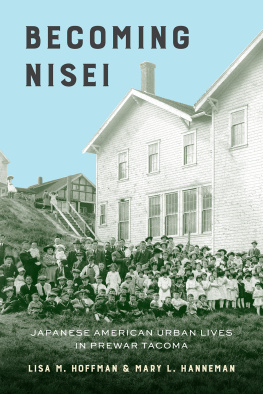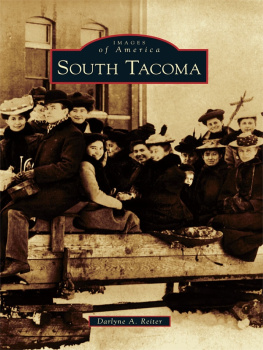THE SCOTT AND LAURIE OKI SERIES IN ASIAN AMERICAN STUDIES
Becoming Nisei
JAPANESE AMERICAN URBAN LIVES IN PREWAR TACOMA
Lisa M. Hoffman and Mary L. Hanneman
UNIVERSITY OF WASHINGTON PRESS | Seattle
in association with
UNIVERSITY OF WASHINGTON LIBRARIES
Becoming Nisei was supported by a grant from the Scott and Laurie Oki Endowment for Books in Asian American Studies.
This publication was also made possible in part by a grant from the Phillip and Estelle De Lacy Endowed Libraries Fund.
Copyright 2021 by the University of Washington Press
Cover and interior design by Katrina Noble
Composed in Cala, typeface designed by Dieter Hofrichter
Maps by Ben Pease, Pease Press Cartography, data compiled by Sarah Pyle 2019
Cover photograph: Teachers, families, and students at the Tacoma Japanese
Language School, ca. 192035 (Courtesy of Washington State Historical Society, 1989.18.17.1)
25 24 23 22 215 4 3 2 1
Printed and bound in the United States of America
All rights reserved. No part of this publication may be reproduced or transmitted in any form or by any means, electronic or mechanical, including photocopy, recording, or any information storage or retrieval system, without permission in writing from the publisher.
UNIVERSITY OF WASHINGTON PRESS
uwapress.uw.edu
UNIVERSITY OF WASHINGTON LIBR ARIES
www.lib.washington.edu
LIBRARY OF CONGRESS CATALOGING-IN-PUBLICATION DATA
LC record available at https://lccn.loc.gov/2020015408
Lc ebook record available at https://lccn.loc.gov/2020015409
ISBN 978-0-295-74821-4 (hardcover), ISBN 978-0-295-74822-1 (paperback),
ISBN 978-0-295-74823-8 (ebook)
The paper used in this publication is acid free and meets the minimum requirements of American National Standard for Information SciencesPermanence of Paper for Printed Library Materials, ANSI z39.481984.
For our children, the future, our hope
CONTENTS
FOREWORD
I was intrigued by the chance to read Becoming Nisei. I grew up in Tacoma, Washington, and have lived my whole life here. The book is about my hometown. I had Japanese grandparents who were Tacoma Isseifirst-generation immigrants from Japan. My mother was Nisei, second-generation Japanese born in the US, who lived all her life in Tacoma. This book is about Tacoma Nisei. My sisters and I (Sansei, third generation) knew lots of Issei and Nisei people in Tacoma.
I was interested to learn more about the place where my mother and her sisters grew upthe middle of what was Tacomas Japanese community. Mom and my aunties told us story after story about the time when there were so many Japanese here. Little things about life and people in the Nihonmachi before World War II. Their stories were about everything. I loved hearing them, but always figured they would only be interesting to us who knew Issei and Nisei.
And the book is about the Tacoma Japanese Language School, an important place in my childhood. You see, Mom, Dad, sisters Diane and Susan, and I, through a series of circumstances, lived in what once was the teachers quarters in that building in the mid-1950sthe same place Principal Masato Yamasaki and his wife, Kuniko, the schools first teacher, lived before World War II. I have memories of that place from so long ago. This book is about that building, the important role it played, and the Yamasakis, all gone now.
I am glad I have this moment to tell you about my experience with Becoming Nisei. The interviews in it are wonderful renditions of many of the stories I have heard over the years, and some I had not. I could hear the voices of the Nisei I knew as I read what they tell us. And I have come away with a deeper understanding of the Issei and Nisei people who shaped my early life in Tacomas postWorld War II Japanese American community. My experience with this book has been a very personal one.
For others of you, reading Becoming Nisei will also be something special. The work of Lisa Hoffman and Mary Hanneman is about a place, now gone, but returned to you through the voices of people who lived there. Lisa and Mary present these memories and stories amid the world events and social dynamics of the timesUS immigration, world war, racismbut with a tight focus on one community and place. That gives the work depth and perspective. It speaks to something we all knowthat places are important to peopleand reminds us of the changing nature of places and the fragility of their communities.
I want to thank Lisa Hoffman and Mary Hanneman for Becoming Nisei and for their other work in this area, Tacomas Japanese Language School: An Oral History, a wonderful collection of recorded interviews with Nisei about the Japanese Language School, their time there as students, and the influence the school had on their lives.
Lisa and Mary were also part of the University of Washington Tacomas effort to create Maru, the bronze memorial to the Tacoma Japanese Language School. It is a marvelous art piece that stands on the university campus. You should visit it when you are here.
Altogether, I am grateful to Lisa and Mary for their work. Theirs is a creative blend of the academic and the compassionate.
I hope you enjoy reading Becoming Nisei.
GREGORY MASAO TANBARA
Tacoma, Washington
ACKNOWLEDGMENTS
This project has been a long time in the making and we are sorry that it did not come out sooner so that more of the Nisei we interviewed could have read their stories in print. Our gratitude to those we spoke with cannot be understated. They opened their hearts and homes, met us at public locations, and shared their childhood memories with usthough we were professors, strangers, and younger, white women. Their graciousness was inspiring and we are forever touched by these experiences, the laughter and even tears we shared. The full list of those we interviewed, along with brief family backgrounds, can be found in appendix Awe thank each individual, deeply and sincerely. Yet there are a few people without whom this project would not have been possible. Dr. Ryo Munekata was a leader of the Tacoma Nisei, and generously shared with us lists upon lists of addresses so we could find as many people as possible. He was forever an optimist with an incredible memory; we learned much from him and were saddened by his passing in 2017. Joe Kosai, who ran Kabuki Restaurant in Tacoma and passed away in 2008, was always present and supportive, working closely with the university on the Maru memorial for the school (sculpture by Gerard Tsutakawa). He willingly spoke with students about his family history and consistently warmed any room he was in. In Chicago, Kazuo Horita (passed in 2013), whom we met in Tacoma at one of the Nisei reunions, spoke passionately about what mattered and helped organize fellow former Tacomans for interviews. We also want to thank all three of the Fujimoto sistersYoshiko Fujimoto Sugiyama, Chiyeko Tadaye Fujimoto Kawasaki, and Kimiko Fujimoto Tanbarafor their participation and grace throughout the project. Not only were we in awe of these three elegant women, all of whom have now passed, but we also felt their genuine kindness. It was a blessing to have met them. We especially wish to show our gratitude to Kimi Tanbara and her family, daughters Diane, Susan, and Merilee and son Gregory. Kimi was a staunch supporter from the early days of this project; Greg was a critical player in getting the memorial for the Japanese Language School established. After reading a draft of this manuscript, Greg moved us to tears by talking about his reaction to the narratives, hearing the voices of those he knew so well. We are grateful that he agreed to provide the books foreword, which is insightful and incisive. We also thank Greg and his sisters for allowing us to include the family photo of their grandmother, mother, and aunt in the Capital Cleaners.








